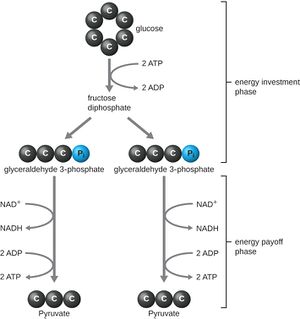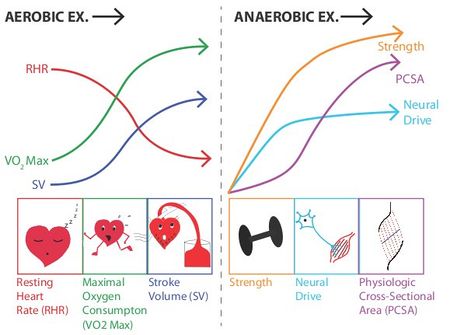Anaerobic Exercise
Original Editor - Lucinda hampton
Top Contributors - Lucinda hampton and Kim Jackson
Introduction[edit | edit source]
Anaerobic exercise is any activity that breaks down glucose for energy without using oxygen. Generally, these activities are of short length with high intensity. The idea is that a lot of energy is released within a small period of time, and the oxygen demand surpasses the oxygen supply.
Exercises and movements that require short bursts of intense energy are examples of anaerobic exercises. These include:
- Weightlifting
- Jumping or jumping rope
- Sprinting[1]
Anaerobic energy system[edit | edit source]
The body has three primary ways of creating energy. These physiological pathways are called energy systems.
- Alactic Anaerobic system (short duration energy – 10 seconds)
- Lactic Anaerobic Systems (medium short duration energy – 60-90 seconds)
- Aerobic System (long term energy from oxygen breakdown- hours)[2]
The anaerobic energy system (also called the lactic acid system) is the body’s way of creating energy in the form of ATP quickly. Primarily using glucose as fuel, this energy system powers the muscles anywhere from ten to thirty seconds for intense efforts. The anaerobic system bypasses the use of oxygen to create ATP quickly through glycolysis (see image 2). Even though this energy system produces energy rapidly, because of anaerobic byproducts, it is limited due to the excess byproducts.
Physiology[edit | edit source]
The anaerobic energy system produces significantly less ATP than its aerobic counterpart and leads to the build-up of lactic acid.
Exercises typically thought of as anaerobic consist of fast twitch muscles eg sprinting, high-intensity interval training (HIIT), power-lifting. Sustained anaerobic exercise, causes a sustained increase in lactate and metabolic acidosis. As the effort becomes more intense, the amount of lactate eventually outpaces the body’s ability to use and clear it. This transition point is referred to anaerobic threshold (AT).
- AT can be directly measured via frequent blood samples measuring the blood lactate level during a graded-exercise regimen. Once the blood lactate values are plotted, the point at which the curve makes a sudden sharp incline represents the AT. Other methods include portal lactate analyzers and mathematical formulas involving heart rate (HR)[3].
- What limits the anaerobic energy system?: The answer is complex and still being studied. Current research suggests that it involves the body’s inability to fully use lactate in addition to the familiar sensation of muscular acidosis. The burning sensations are the result of hydrogen ions, which increase acidity in the muscles[4].
Through the process of glycolysis, blood glucose or muscle glycogen is converted to pyruvate, which will either enter the mitochondria or be converted to lactate, depending on the intensity of exercise.
- Pyruvate enters the mitochondria at exercise intensity levels below the AT
- At intensity levels above AT the capacity for mitochondrial respiration (the complete breakdown of carbohydrate) is exceeded and pyruvate is converted to lactate.
Lactate production should not be viewed as a negative metabolic event, but as a consequence of high-intensity exercise. With this increasing exercise intensity there is a shift toward the recruitment of more fast-twitch muscle fibers, which have metabolic characteristics that are geared toward glycolysis. Slow twitch oxidative muscle fibers are metabolically suited for lactate oxidation[5].
Anaerobic Capacity and Anaerobic Power[edit | edit source]
Anaerobic capacity: Maximal work performed during maximum-intensity short term physical effort; reflects the energy output capacity of anaerobic glycolysis.[6]
- Maximal anaerobic capacity tests are subdivided into maximal oxygen debt test, ergometric tests (all-out tests and constant load tests), measurement of oxygen deficit during a constant load test and measurement of peak blood lactate (the measurement of the maximal oxygen debt is not valid and reliable enough to be used as an anaerobic capacity test).
Anaerobic power: Maximal power (work per unit time) developed during all-out, short-term physical effort; reflects energy-output capacity of intramuscular high-energy phosphates (ATP and PCr) and/or anaerobic glycolysis. This system is depleted quickly and is used for short bursts of intense power output[7]
- Anaerobic power tests include force-velocity tests, vertical jump tests, staircase tests, and cycle ergometer tests[8].
Benefits[edit | edit source]
Anaerobic exercises push your body and lungs to rely on energy sources stored in the muscles. The benefits include:
- Increases bone strength and density: Anaerobic activity (like strength training) can increase the strength and density of bones, decreasing the risk of osteoporosis.
- Promotes weight maintenance: In addition to helping the body handle lactic acid more effectively, anaerobic exercise can help you maintain a healthy weight.
- Increases power: It can increase your power. A 2008 study conducted on division 1A baseball players found that players who did eight 20- to 30-second wind sprints three days a week saw their power increase by an average of 15 percent throughout the season.
- Boosts metabolism: Anaerobic exercise helps boost metabolism as it builds and maintains lean muscle. The more lean muscle you have, the more calories a person burns during your next exercise session. High-intensity exercise is also thought to increase your post-workout calorie burn.
- Increases lactic threshold: By regularly training above a persons anaerobic threshold, the body can increase its ability to handle lactic acid, which increases your lactic threshold or the point at which they experience fatigue. That means the person is able to work out harder, for longer.
- Reduces risk of disease: Gains in strength and bone density attained by high-intensity anaerobic training, like bodyweight squats and pushups, can reduce the risk for diabetes and coronary artery disease.
- Protects joints: By building muscle strength and muscle mass, the joints will be better protected, meaning they have greater protection against injury.
- Boosts energy: Consistent anaerobic exercise increases the body’s ability to store glycogen, giving you more energy for physical activity. This can improve your athletic ability.[1]
Resources[edit | edit source]
- bulleted list
- x
or
- numbered list
- x
References[edit | edit source]
- ↑ 1.0 1.1 Healthline Anaerobic Exercise Available from: https://www.healthline.com/health/fitness-exercise/anaerobic-exercise#types (accessed 24.3.2021)
- ↑ MTP THE IMPORTANCE OF ANAEROBIC CAPACITY (AND HOW TRAINING AEROBICALLY DRAMATICALLY IMPROVES IT ) Available from:https://muaythaipros.com/the-importance-of-anaerobic-capacity-and-how-training-aerobically-dramatically-improves-it/ (accessed 24.3.2021)
- ↑ Patel H, Alkhawam H, Madanieh R, Shah N, Kosmas CE, Vittorio TJ. Aerobic vs anaerobic exercise training effects on the cardiovascular system. World journal of cardiology. 2017 Feb 26;9(2):134. Available from:https://www.ncbi.nlm.nih.gov/pmc/articles/PMC5329739/(accessed 25.3.2021)
- ↑ Trainerroad Anaerobic Energy Available from:https://www.trainerroad.com/blog/anaerobic-energy-system-what-it-is-why-its-important-and-how-to-train-it/ (accessed 24.3.2021)
- ↑ Gladden LB. Muscle as a consumer of lactate. Medicine and science in sports and exercise. 2000 Apr 1;32(4):764-71.Abvailable from: https://www.researchgate.net/publication/12539645_Muscle_as_a_consumer_of_lactate(accessed 25.3.2021)
- ↑ https://medical-dictionary.thefreedictionary.com/anaerobic+capacity
- ↑ AP Available from: https://medical-dictionary.thefreedictionary.com/anaerobic+power (accessed 24.3.2021)
- ↑ Vandewalle H, Péerès G, Monod H. Standard anaerobic exercise tests. Sports medicine. 1987 Jul;4(4):268-89.Available from: https://pubmed.ncbi.nlm.nih.gov/3306867/ (accessed 24.3.2021)










